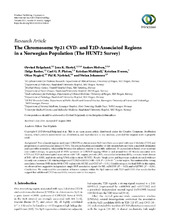| dc.contributor.author | Helgeland, Øyvind | en_US |
| dc.contributor.author | Hertel, Jens Kristoffer | en_US |
| dc.contributor.author | Molven, Anders | en_US |
| dc.contributor.author | Ræder, Helge | en_US |
| dc.contributor.author | Platou, Carl Geoffrey Parrinder | en_US |
| dc.contributor.author | Midthjell, Kristian | en_US |
| dc.contributor.author | Hveem, Kristian | en_US |
| dc.contributor.author | Nygård, Ottar | en_US |
| dc.contributor.author | Njølstad, Pål R. | en_US |
| dc.contributor.author | Johansson, Stefan | en_US |
| dc.date.accessioned | 2015-07-31T09:28:42Z | |
| dc.date.available | 2015-07-31T09:28:42Z | |
| dc.date.issued | 2015 | |
| dc.identifier.issn | 1687-8337 | |
| dc.identifier.issn | 1687-8345 | |
| dc.identifier.uri | https://hdl.handle.net/1956/10183 | |
| dc.description.abstract | Background. Two adjacent regions upstream CDKN2B on chromosome 9p21 have been associated with type 2 diabetes (T2D) and progression of cardiovascular disease (CVD).The precise location and number of risk variants have not been completely delineated and a possible synergistic relationship between the adjacent regions is not fully addressed. By a population based cross-sectional case-control design, we genotyped 18 SNPs upstream of CDKN2B tagging 138 kb in and around two LD-blocks associated with CVD and T2D and investigated associations with T2D, angina pectoris (AP), myocardial infarction (MI), coronary heart disease (CHD; AP or AMI), and stroke using 5,564 subjects from HUNT2. Results. Single point and haplotype analysis showed evidence for only one common T2D risk haplotype (rs10757282|rs10811661: OR = 1.19, 𝑃� = 2.0 × 10−3) in the region.We confirmed the strong association between SNPs in the 60 kb CVD region with AP, MI, and CHD(𝑃� < 0.01). Conditioning on the lead SNPs in the region, we observed two suggestive independent single SNP association signals for MI, rs2065501 (𝑃� = 0.03) and rs3217986 (𝑃� = 0.04). Conclusions. We confirmed the association of known variants within the 9p21 interval with T2D and CHD. Our results further suggest that additional CHD susceptibility variants exist in this region. | en_US |
| dc.language.iso | eng | eng |
| dc.publisher | Hindawi | eng |
| dc.rights | Attribution CC BY | eng |
| dc.rights.uri | http://creativecommons.org/licenses/by/3.0/ | eng |
| dc.title | The Chromosome 9p21 CVD- and T2D-Associated Regions in a Norwegian Population (The HUNT2 Survey) | en_US |
| dc.type | Peer reviewed | |
| dc.type | Journal article | |
| dc.date.updated | 2015-04-08T12:02:12Z | en_US |
| dc.description.version | publishedVersion | en_US |
| dc.rights.holder | Copyright 2015 Øyvind Helgeland et al. | |
| dc.source.articlenumber | 164652 | |
| dc.identifier.doi | https://doi.org/10.1155/2015/164652 | |
| dc.identifier.cristin | 1229721 | |
| dc.source.journal | International Journal of Endocrinology | |
| dc.source.40 | 2015 | |
| dc.subject.nsi | VDP::Midical sciences: 700::Clinical medical sciences: 750::Endocrinology: 774 | en_US |
| dc.subject.nsi | VDP::Medisinske fag: 700::Klinisk medisinske fag: 750::Endokrinologi: 774 | en_US |
| dc.subject.nsi | VDP::Midical sciences: 700::Basic medical, dental and veterinary sciences: 710::Medical genetics: 714 | en_US |
| dc.subject.nsi | VDP::Medisinske fag: 700::Basale medisinske, odontologiske og veterinærmedisinske fag: 710::Medisinsk genetikk: 714 | en_US |

